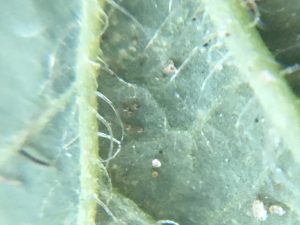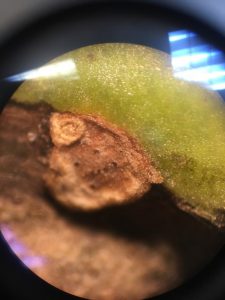I would like to share some things that I have been seeing in the melon fields over the last 2 weeks. Some of these photos are taken with my camera phone and hand lens and may be slightly blurry. However, many people ask about what I am looking for with my hand lens so I decided pictures from that perspective would be appropriate. Keep in mind, the melon crop is overall and THESE PESTS ARE NOT EVERYWHERE, JUST SOMEWHERE……….think about it.
White Fringed Beetle Larvae (left) and direct seeded cantaloupe chewed off below ground (right)


White fringed beetle larvae is a soil borne pest that is most common in high residue situations like winter grazing or a pasture or hayfield. This larvae is very difficult to control and options are limited. This pest was found several inches deep in the soil. The larvae is not very mobile in the soil and will not move from plant to plant. This was on direct seeded cantaloupe. Direct seeded crops are much more susceptible to soil borne insects due to the small tender tissue. On some crops, recommendations for control of white fringed beetle are as follows: do not plant if white fringed beetle larvae are present.
Seed Corn Maggot on Watermelon

Problems with seedcorn maggots in transplanted crops are popping up all over south Georgia this Spring. While this is a rare occasion (use of transplants avoids many soil borne insect problems), that makes it no less severe when it occurs. Maggots can kill tender young transplants, but cause minimal injury once the plants become established and harden off.
The adult files look like small house flies and are attracted to decaying organic matter. For this reason, they tend to be worse in fields where manure, weeds or a cover crop were plowed in just before planting. For future reference, it is generally recommended that this plowing occur at least three weeks before planting/transplanting. They still can occur in “clean” fields as the transplant media, which is high in organic matter, can attract flies once it is planted into the field.
Seedcorn maggots are worse under cool, moist conditions. This both slows the growth of the plant so that it is susceptible to damage for a longer period and is favorable to the maggots. One research report from Purdue indicated that damage to transplants dropped dramatically (from 60 to 80 percent down to 10 to 0 percent) as soil temperature increased above 70 degrees.
There are no effective rescue treatments for seedcorn maggot infestations. A pre-plant treatment with diazinon should avoid this problem, but is rarely done as the problem is rare. A foliar application with a broad spectrum insecticide after setting/resetting the plants should help suppress fly activity in the field and buy some time for plants to become established.
Mites

I apologize for the fuzziness of the image. This is mite eggs on watermelon. The mite disappeared before I could get a picture of it. There are about 5-6 eggs in this one little pocket on the leaf. I believe that the mite was actually a carmine mite and not a two spotted spider mite. I did observe TSSM populations in another field this week. Scouting for mites is rather simple. They generally appear on a border of the field, especially around a big tree or even a dirt road.
Gummy Stem Blight Pycnidia

This is another hand lens photo that shows pycnidia of the gummy stem blight pathogen. There was just this small portion of it on the whole leaf. If I look hard enough, I can find it in many places; however, the majority of necrosis we are seeing on a leaf is not due to gummy stem blight. What we generally see is transplant shock, high soluble salt levels in the tray (associated with decreased irrigation, and/or leaves that are necrotic (brown) from a previous period of inadequate moisture.